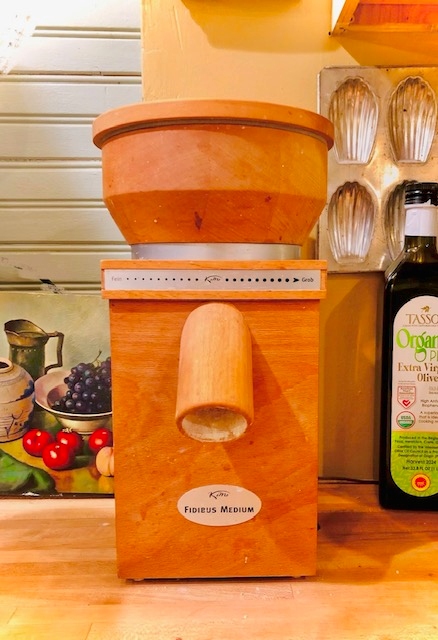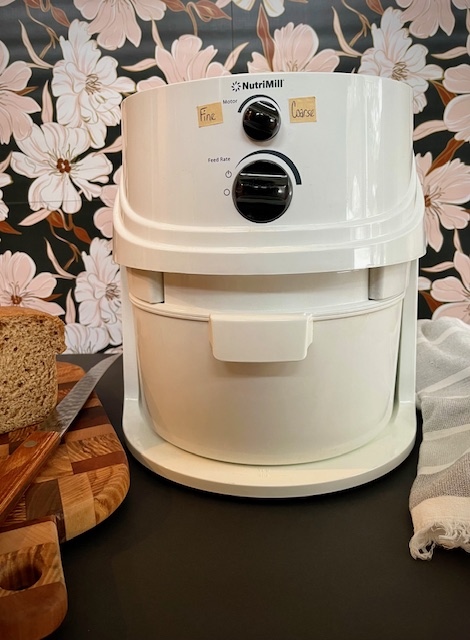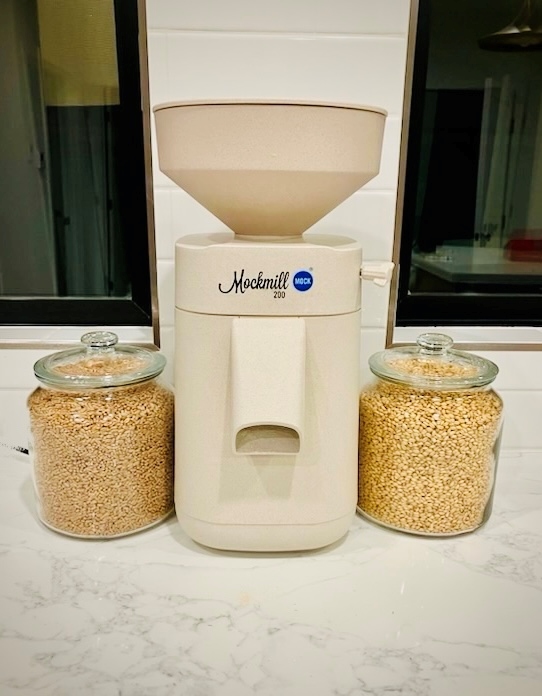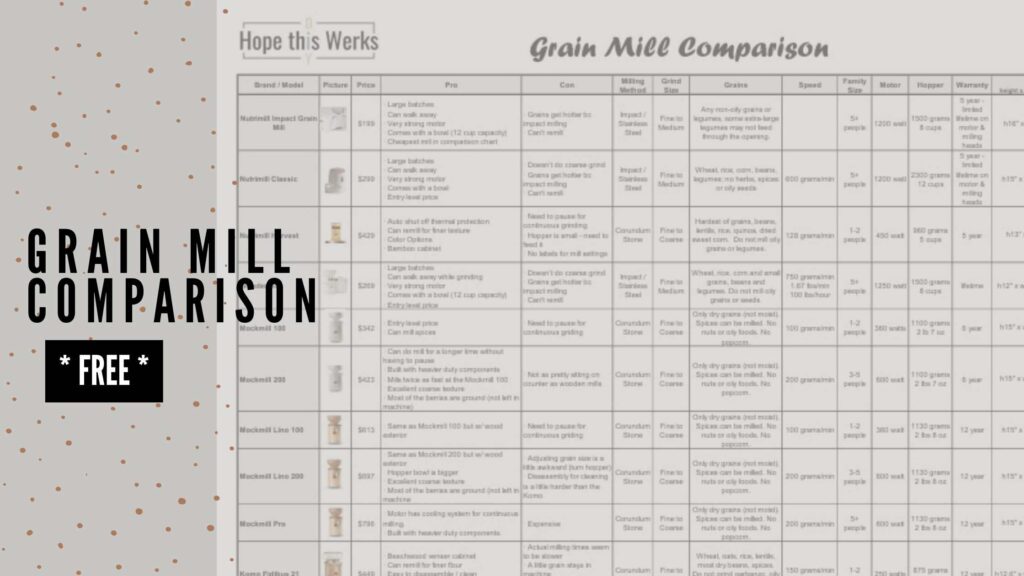Ah, a grain mill. If you’re here, you’ve probably decided it’s time to step up your game and grind your own flour. Why? Because you want to eat the healthiest flour available, fresh milled flour tastes so much better than store-bought, wheat berries last for a very long time (@supplychainissues) or maybe you’re just looking for a new way to impress your sourdough starter friends. Whatever the reason, buckle up because we’re about to embark on a journey of flour, power, and…well, probably some puns.
A while ago, my friend Julie texted me wanting to know which grain mill to buy. Of course, I forwarded her a link to my grain mill (which I love). Julie responded with some great questions. While we were texting I found out that she had another friend who owned a grain mill. The battle is on: Which one of Julie’s friends would be able to convince her that her grain mill is the best?

Outline for Grain Mill Discussion
We are going to journey through the world of grain mills. Most of all, we are going to help you know what important questions to ask. I want you to choose a grain mill that you will love, give it a cute name, and maybe even include it in your family pictures.
This is going to be a surprisingly easy process. If you answer four basic questions, then you will have a good idea of which grain mill will be best for YOU. If you have a toddler, you have to answer more than four questions in 60 seconds … so this will be easy peasy!
I will occasionally refer to a grain mill comparison spreadsheet that I made for us. (“us” … Yes, I am currently dropping not-so-subtle hints to my husband that I would love another mill for my birthday. I am concerned that instead of a new grain mill … he is going to give me a gift card for counseling because I have an obsession). On the spreadsheet, I compare the top 18 electric grain mills for home use. There are a bunch of facts about each grain mill (i.e., price, picture, hopper size, types of grain it can grind, warranty, motor power, etc.). If you happen to like to get things for FREE … click here for my FREE spreadsheet. It will definitely help you with your selection process.
For this post, we will only “sift” through electric grain mills (pun intended). Of course, there are wonderful hand-cranked mills out there. If you want a solar-powered grain mill, then you might want to check out my husband’s blog post.
There is something romantic about a hand-cranked mill. It feels comfy and cozy to have the dream of cooking bread in your dutch oven over an open fire if the power goes out. Let’s keep this purchase as an option for our second or third grain mill (not that you ever need more than one … but sometimes hobbies get out of control). I love your dream!
Right now, you need to figure out how to make baked goods with freshly milled flour. It might take a few attempts to tweak your recipes to perfect them. Let’s purchase a grain mill that provides you the greatest chance of using it multiple times a week (which is why I am only talking about electric mills in this blog). If you wanted a hand-cranked mill for an upper body workout … by all means … bench press your kids or dog. (Hand-cranked mills need to be attached to the edge of your counter every time you use them, they can struggle to make flour fine enough for bread, it will take about 30 minutes to grind 4 cups of wheat, and can be extra messy.)
Grain Mill Question #1
Do you want to grind using stone or impact/steel burrs?
These questions are in no particular order … they are equally important (just like chips and salsa – yinz need both). “Yinz” is a shoutout to my fellow Pittsburghers.
Even though this is the first question, I didn’t know I needed to ask myself this when I purchased my first grain mill. Ring-Ring-Ring – “Howdy, Father-in-Law … What type of grain mill do you have?” That was the one and only question I asked when I purchased my first mill. My friend, Julie, is starting her fresh milled flour journey better than I did.
Stone Mill
This is the OG of grain mills: stones. These bad boys are the grandma-approved option because they use actual stones to grind your wheat. That’s right—stones. Like the ones you find in your garden, but more sophisticated and with fewer weeds attached. The majority of grain mills use corundum stones to grind grain. Fun Fact: corundum stones are almost as hard as diamonds. This ensures the stones will survive through your mill’s lifespan.
Stone Mills:
- Keep the temperature low during the milling process (temperatures above 120 degrees can destroy heat-sensitive nutrients). You can brag about your vitamins on Instagram.
- You can remill flour if it is not fine enough. (I think my impact/steel burr mill grinds wheat berries just a hair finer than my stone mill … not that I’m over here with a magnifying glass comparing flour granules.)
- They do a good job at getting a coarse grind (who doesn’t love fresh ground grits … with or without cheese … maybe a few jalapenos).
- Some have beautiful wooden exteriors … pretty enough to leave on your countertop (versus impact mills – large and white). This is for people who want to grind wheat in style. These are the Maseratis of grain mills—sleek, modern, and guaranteed to make your neighbors jealous.
- A lovely nod to the past … using a stone mill makes you feel like a pioneer (minus the cholera).
- The machines are smaller than impact mills because they don’t have an attached bowl (impact mills have attached bowls).
- Unless you buy the more expensive stone mills that have cooling systems for continuous grinding, you need to take breaks to cool down the stones (versus impact mills – you can grind much longer).
- The hoppers are smaller so you might need to refill the hopper a few times (versus impact mills – the hoppers tend to be much bigger).
- You need to have a gorgeous bowl for the flour to fall into. Pretty bowls make all things taste better. (versus impact mills – they have attached bowls)
- Takes a longer time to grind than an impact mill (but much faster than a snail on vacation … so don’t worry too much about this).
Impact Mill
Fewer mills have steel burrs to grind the grain (versus the plentiful stone mills). Steel mills are often referred to as impact mills.
Impact Mills:
- Are usually cheaper than stone mills.
- Have an attached bowl to collect the flour. Since the bowl is attached, you can walk away for a minute because the bowl will not overflow.
- Have very strong motors (perfect for impatient bakers who want their flour NOW). The strong motors allow you to grind for a long time.
- Loud – If you’ve ever wondered what it’s like to have a jet engine in your kitchen, this is your chance.
- Do a great job of grinding fine flour (for breads and pastries). I don’t know if it’s just me, but my impact/steel burr mill grinds my wheat a little finer than the stone mill. Not a big deal, just something I’ve noticed while baking.
- Don’t do a good job of grinding grain coarsely … grits aren’t happy about this.
- Have larger hoppers = large batches of grinding. You can put in many cups of wheat berries which also helps you walk away for a minute.
- Have a larger footprint … bigger machines because of the attached bowl. You probably won’t leave this on your countertop.
- You cannot remill flour if it is not fine enough (versus stone mills – you can send it through again).
- Heat the flour to a higher temperature – typically not above 118° (versus stone mills – are cooler when milling).

Grain Mill Question #2
Do you care about aesthetics?
I know this question may sound vain, but it is a legitimate issue to consider. I know many friends who desire to leave their mill on the counter … they want it to look as pretty as possible. They decided to spend the extra money on the mill that has a wood exterior. The wooden mills look like they belong in a museum.
Impact mills do not have a wood exterior. Additionally, since impact/stainless steel mills come with an attached bowl, they are larger. They would take up more surface area on your countertop. Some lucky people have biggie-sized kitchens … then the footprint of the machine would not matter.
You might want to consult my spreadsheet for the height of the mills. My cupboards are a smidge lower than they were in my last kitchen. Some of the mills are too tall and would not fit under my cabinets. Just another consideration …
Grain Mill Question #3
How much baking are you doing in a week (how powerful should your mill be)?
Are you single and enjoy baking fabulous cookies on the weekend? Do you have a family of seven (including teenage boys who eat everything in sight)? Do you make all your bread products (sandwich bread, hamburger buns, english muffins, cakes, tortillas, etc.)?
Impact mills have strong motors that are workhorses. They can grind crazy amounts of flour without needing a break. No nap time is needed for this machine! Impact mills usually come with one motor size – big! There is not a variety to choose from. You would have to spend considerably more money for a stone mill with the same amount of power.
Stone mills come with a wide range of motor sizes. The bigger the motor = the more expensive the mill. Be sure to select a mill with a motor that matches your usage. If you grind flour for longer than recommended, you could glaze the stones. Glazing is when the stones get too hot. They get covered with the particles they are grinding. This turns the stones into a smooth surface so that they no longer can grind the wheat berries into flour.
Random Tip: The stones in your mill can also become glazed if you grind oily items (i.e., sesame seeds, flax, poppy, coffee, nuts). None of the mills on my comparison spreadsheet are made for grinding oily ingredients. Another culprit of glazing is moisture in your grain. Don’t mill grains that are not fully dry. If your stones are mildly glazed, you can run 2 cups of rice through your machine. This has a good chance of cleaning the stones. Your owner’s manual would be a good resource for this problem too.
Back to the discussion of power … examples of motor sizes for a stone mill would be:
- Komo Fidibus has a 250-watt motor that would be great for a small amount of flour.
- Mockmill 200 has a 600-watt motor that could power through a family-size quantity of grain.
- Mockmill Pro or Komo Fidibus XL Plus for Pros have huge motors with cooling systems for continuous milling.
As you are deciding which mill is best for you, if it would help you to know motor sizes for the various grain mills … my free spreadsheet has all of the motor sizes on it. Click here.
Grain Mill Question #4
What grains do you want to mill?
All of the machines discussed on my spreadsheet will make lovely fine flour for bread or pastries. Only the stone mills have the ability to consistently grind to a coarser consistency. This would be important if your family loves grits or cream of wheat for breakfast.
Each machine will come with an owner’s manual containing a do’s and don’ts list of things to grind in your machine. Some machines can’t grind herbs, others can’t grind garbanzo beans, and some machines are mad if you grind spices. Check out my spreadsheet for the list of items for each machine.
That’s all folks! Four easy peasy questions!

If you were wondering which mill Julie bought (from the beginning of this post) … this is her beautiful Mockmill 200. Excellent choice, Julie!
Grain Mill Suggestions
Now, let’s work through a few examples to demonstrate how these four questions can help us figure out what mill we want to purchase.
Please note that the prices mentioned will be as of the date of the blog. Sorry about inflation! I know the increased prices will make you sad. Just think … why not buy your mill today so that the prices don’t increase again next month?
I also want to mention that you might be tempted to use your Vitamix, an attachment for your KitchenAid, or a cheaper milling option … please don’t opt for one of these milling solutions. These cheaper options do not grind the wheat berries fine enough to make a quality loaf of bread. It will feel less like baking and more like sculpting kinetic sand into a loaf. You will be discouraged. I highly recommend buying a real grain mill.
Example #1
Single Person – Fixed income (money is tight) – Few health ailments – Makes bread once a week – Occasionally makes cookies for family and friends.
Question #1 Do you want to grind using stone or impact/steel burrs?
- Single Person’s Response: It doesn’t really matter. I didn’t have an Aunt or Mom that ground flour at home … so I don’t have a sentimental attachment to either style. I am on a fixed income so I like the lower cost of the impact mill. I don’t need that much flour though, therefore I could get a stone mill with a small motor.
Question #2 Do you care about aesthetics?
- Single Person’s Response: Not really … I live in a small apartment. My kitchen is small. I am going to store my mill in the hallway closet. I don’t need my mill to look fancy.
Question #3 How much baking are you doing in a week (how powerful should your mill be)?
- Single Person’s Response: I won’t be baking that much. I will need a few cups for my loaf of bread for the week. When family comes around during the holidays I will make their favorite cookies for Christmas.
Question #4 What grains do you want to mill?
- Single Person’s Response: Just wheat berries. I am a northern girl who never understood the whole grit thing.
Winnie's Recommendation:
- The Nutrimill Impact Grain Mill is the cheapest mill … coming in at $199. It only weighs 10 pounds, so you can easily carry it from the hallway closet to the countertop.
- The Wondermill (#ad) is the lightest mill. It only weighs 7.25 pounds. The lighter weight might be nice for when you aren’t feeling very well. It does cost a little more … $269.
I would not recommend any of the stone mills. The lightest one is over 13 pounds … that extra weight might prohibit you from getting it out of the closet when your body feels achy. Additionally, the cheapest stone mill is $339. It might be nice to save the extra money for the next car repair.
Example #2
Empty Nesters – Decent Income – Makes all bread products – Hosts all family holidays.
Question #1 Do you want to grind using stone or impact/steel burrs?
- Empty Nester’s Response: I would prefer a stone mill because that’s what my neighbor has, but I don’t know much about either … I don’t have a strong opinion.
Question #2 Do you care about aesthetics?
- Empty Nester’s Response: I DO care what my mill looks like. I am going to leave it on my counter all the time. Also, wood just makes me happy! I like the idea of a smaller mill being on my countertop. I also just bought the cutest bowl at TJ Maxx that could catch the flour as it is ground.
Question #3 How much baking are you doing in a week (how powerful should your mill be)?
- Empty Nester’s Response: Every week I seem to do more baking than empty nesters should have to. I make all of our bread … we have toast every morning. I also make all of our other bread products. Mexican is one of our favorites … there is nothing better than freshly made tortillas. I also enjoy making cakes and cookies … sure, we are trying to lose weight … but life is short.
Question #4 What grains do you want to mill?
- Empty Nester’s Response: Pretty much just wheat berries. I don’t find a need to crack any grains.
Winnie's Recommendation:
- The Harvest Nutrimill is a very popular option. It is the cheapest of the stone mills that have a wood exterior. It has a 450-watt motor, which means that it would be good for when you make bread for the two of you. You will need to let it rest when you are holiday baking. It is not big enough to endure those long baking extravaganzas. It is only 13” tall, making it one of the shorter stone mills. It can easily crack field corn if you decide that you want to give grits a try! This mill is $429 – not bad!
- If you want to splurge a little … upgrade to the Mockmill Lino 200 or the Komo XL.
- The Mockmill Lino 200 has a 600-watt motor. Comes with a lovely wood exterior. It grinds at 200 grams per minute. The hopper bowl holds 1130 grams (versus the Harvest Nutrimill only holds 960 grams). This has a 12-year warranty (versus the Harvest has a 5-year warranty). It costs $697.
- The Komo XL also has a 600-watt motor. This machine grinds the fastest of these three options: 300 grams per minute. It comes with a beechwood exterior and attractive finger-jointed corners. The hopper bowl holds 1190 grams. This mill also has a 12-year warranty. It costs $739.
I might not recommend any of the impact mills. Since you want to put it on your countertop, the stone mills are the only ones that come with a wood exterior and a smaller footprint (because they do not have an attached bowl). If you change your mind and care more about doing lots of baking without having to let the machine cool down (versus storing a cute machine on your countertop) … the Classic Nutrimill would be a great option.
Example #3
Family of Six – Very careful with money – Very concerned about every aspect of health.
Question #1 Do you want your mill to grind using stone or impact/steel burrs?
- Family of Six Responses: We want a stone mill. We don’t even want to get close to a single nutrient being lost if the heat spikes during milling.
Question #2 Do you care about aesthetics?
- Family of Six Responses: Not really. My house is always a mess with all of the kid’s school stuff and sports.
Question #3 How much baking are you doing in a week (how powerful should your mill be)?
- Family of Six Responses: I am constantly baking! Thankfully my oldest child is able to help out with some of the baking. We have sandwiches almost every day for lunch. We love our cookies. Pizza is a family favorite!
Question #4 What grains do you want to mill?
- Family of Six Responses: My kids don’t mind cream of wheat for breakfast and most of them even like grits. However, we will predominantly be making baked goods.
Winnie's Recommendation:
- The Mockmill 200 would be a winner for you. It has all of the power that you would need … with a small price tag (it is only $423). It doesn’t cost as much as the other 600-watt mills because it does not have wood on the outside. The casing is white and made from renewable materials. It only has a 6-year warranty (which is shorter than other 600-watt mills). If you wanted the wood version of this machine it would be $697 (but it would also have a 12-year warranty). This is a stone mill so it keeps the temperature lower during grinding.
- If you happen to want to dedicate some extra money towards a mill, you might want to consider the Komo XL. It does have a lovely wood exterior in case you change your mind about wanting to leave it out on the counter.
Since coarsely cracking grains and keeping the temperature low during milling are important to you, I would not suggest an impact mill. However, an impact mill would be cheaper and could mill large quantities of flour without pausing.
Final Thoughts
Answering four simple questions can help you have success in picking out your grain mill. It is like choosing a dog: it needs to fit your needs, your lifestyle, and your flour-obsessed heart. Whether you’re a stone mill purist or an impact steel speedster … there’s a mill out there waiting to make all your baking dreams come true.
So go forth, dear reader, and grind. Your homemade bread, pasta, and pancakes will thank you—and so will your Instagram followers.
Now, if you’ll excuse me, I have a date with a NutriMill and 10 pounds of wheat berries. Wish me luck.
Purchasing a Grain Mill
If you want to use my coupons and affiliate links to order a mill, here are a few options (affiliate links = I make a small commission at no extra cost to you).
Nutrimill: If you would like to order directly from Nutrimill, here is my affiliate link directly to their website. If you use my link, you will receive an additional $20 off on any qualifying purchase. If you prefer to use a coupon code at checkout, then use “HOPETHISWERKS” for $20 off of qualifying purchases.
Pleasant Hill Grain: This company sells a large selection of grain mills. Here are some of the brands of mills that they sell: Komo, Nutrimill, Wondermill, Mockmill. This is my affiliate link directly to their website. If you use my link you will get free shipping on orders over $75.
Amazon: I don’t currently have a coupon code for Amazon (I do make a small commission at no cost to you) … but here are some of the mills that I would recommend: Nutrimill Classic, Nutrimill Harvest, Wondermill, and Komo Fidibus Classic.
Some sentences or ideas may be from chatgpt.









2 responses to “Grain Mill: How to Choose the Best One”
Thank you for this super helpful guide! I’ve been undecided on which grain mill to buy, and your post helped me pick the perfect one.
I’m so glad it helped! Enjoy your new grain mill … there’s nothing like fresh milled flour!